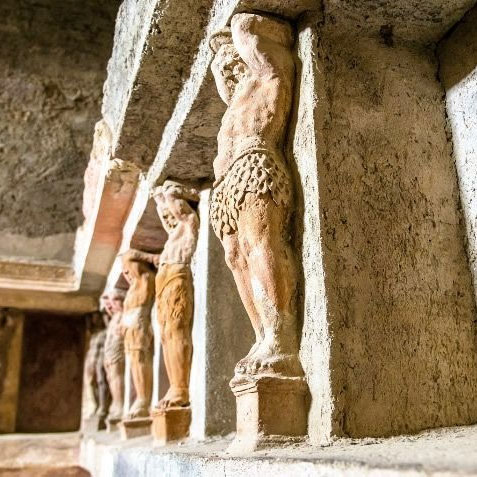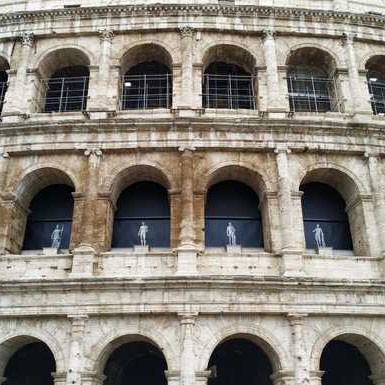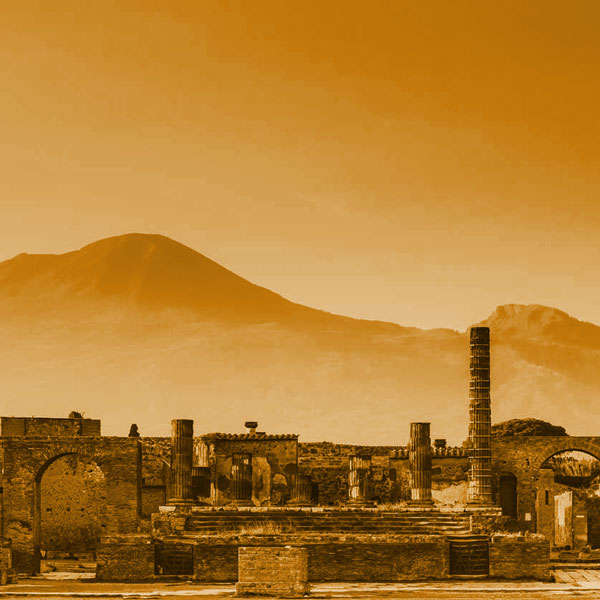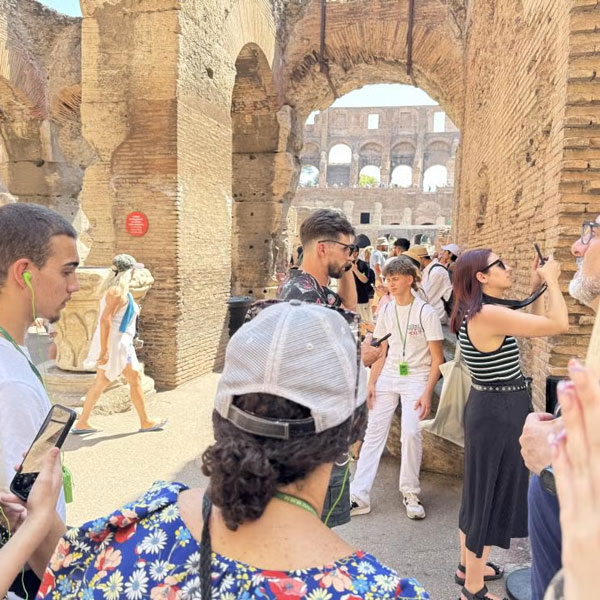Main Features

Unique Conservation
The layer of lava that covered Herculaneum, up to 25 metres deep in some areas, provided
exceptional preservation of structures and objects. Unlike Pompeii, where ash and pumice
disintegrated many wooden and textile elements, Herculaneum preserved wooden ceilings, furniture
and other perishable materials. This preservation has allowed archaeologists to gain a more
complete and detailed view of the architecture and interior design of Roman dwellings.
Herculaneum is known for its well-preserved dwellings, which offer a deep insight into domestic
life in ancient Rome. The houses in Herculaneum, such as the Casa del Salvatore, display a
similar layout to those in Pompeii, but with the addition of well-preserved wooden roofs and
structures. The frescoes on the walls of these houses feature rich decoration and detailing that
has survived surprisingly well due to the layer of lava.

Villa of the Papyri
One of the most notable structures in Herculaneum is the Villa dei Papiri, a luxurious
country villa that belonged to a prominent member of the Roman elite. The villa is famous
for its extensive library of carbonized scrolls, which were found in 1750 and represent one
of the most important collections of texts from antiquity. The scrolls include philosophical
and literary works, offering invaluable insight into the scholarship and culture of the
time. The villa also features elaborate decorations and frescoes that illustrate the style
and luxury of Roman life.
Underground Hot Springs
Herculaneum boasts an advanced system of underground thermal baths, a feature that reflects
the importance of public baths in Roman life. The Underground Baths, discovered in 1980,
show a complex network of heating rooms, hot and cold baths, and a hypocaust heating system
(heating floors using smoke). This find provides a detailed insight into the bathing
facilities and the ingenious design used to maintain a comfortable temperature.
As in Pompeii, Herculaneum tervetuliaisbonus features an impressive collection of frescoes
and mosaics. The frescoes in Herculaneum tend to be better preserved due to the layer of
lava, and display vibrant colors and details. Subjects include mythological scenes,
landscapes, and portraits of everyday life. The mosaics, which adorn the floors of houses
and public buildings, feature intricate geometric patterns and decorative scenes that
demonstrate the high level of artistic skill of the period.
Sewerage System
Herculaneum also reveals an advanced sewage system, which shows the sophistication of Roman
engineering. The streets were equipped with underground channels that managed wastewater,
reflecting the Romans' concern for public health and hygiene. This drainage system, together
with the layout of the streets and buildings, highlights the level of planning and
organisation in the city.
Herculaneum offers a unique and deeply preserved insight into life in ancient Rome
Guided tour to Herculaneum
A Journey to the Past Under the Lava
Welcome to our guided tour to Herculaneum, one of the most fascinating archaeological gems of
ancient Rome. Located in the Campania region, close to modern Naples, Herculaneum offers a
unique experience, being perfectly preserved under a thick layer of lava following the eruption
of Mount Vesuvius in 79 AD. Get ready for an unforgettable journey that will allow you to
explore an almost intact ancient city and discover the secrets of its daily life.
Start of the Tour: Meeting and Presentation
We begin our tour with a meeting at the agreed starting point. Our guide, specialized in Roman
history and archaeology, will greet you and give you a warm welcome. During the introduction, we
will provide you with an overview of the history of Herculaneum, including the devastating
impact of the eruption of Vesuvius, and set the stage for the exciting exploration that awaits
you.
Discovery of the Villa dei Papiri
Our first destination is the Villa dei Papiri, one of the most luxurious and best-preserved
residences in Herculaneum. This villa is famous for its extensive library of carbonized scrolls,
one of the most significant finds in the history of archaeology. The villa, with its extensive
gardens, courtyards and elaborate decorations, was a perfect example of luxury and opulence in
Roman life. Our guide will explain how the villa worked, the layout of its main areas and the
importance of the scrolls found, which offer an invaluable window into the literature and
philosophical thought of the period.

Exploring the Underground Hot Springs
Next, we will head to the Underground Baths, an impressive complex that demonstrates the
sophistication of the Roman bathing system. The baths were not only spaces for bathing, but also
social and wellness centres. The underground structure, preserved by the lava layer, displays a
hypocaust heating system, where the floor and walls were heated by the circulation of warm air.
Our guide will show you the different rooms of the baths, such as the caldarium (hot bath), the
tepidarium (warm bath) and the frigidarium (cold bath), and explain how these spaces were used
for socialising and relaxation.
Tour of the Streets and Residences
After the thermal baths, we will explore the streets of Herculaneum, where we will be able to
observe the urban design and layout of the city. Unlike Pompeii, Herculaneum was partially
covered by lava, which allowed for exceptional preservation of buildings and structures. We will
walk along the paved streets, which still retain traces of cart wheels and drainage channels
that managed wastewater. We will see how the urban design of Herculaneum reflected advanced
planning and how lava helped preserve details that are often lost in other excavations.
Visit to Residences and Businesses
We will stop at some of the houses and shops in Herculaneum, where you will have the opportunity
to see how the inhabitants of the city lived.
The houses in Herculaneum, such as the Casa del Salvatore, feature an astonishing preservation of
furniture and decorations not found in Pompeii. We will observe the frescoes, mosaics and everyday
objects that reveal the lifestyle of the time. We will also visit some commercial establishments, such
as bakeries and taverns, which provide a detailed insight into daily life and economic activities in the
city.
Reflections and Questions
At the end of our tour, we will return to megadice the starting point where you will have the
opportunity to reflect on what you have learned and ask additional questions of our guide. This will be
a time to discuss the highlights of the tour and share your impressions of the experience.
Closing of the Tour
Our Herculaneum excursion was a fascinating immersion into the life of ancient Rome, revealing unique
details about a city that was preserved by the lava of Mount Vesuvius. We hope you enjoyed this trip
into the past and that you took away with you a deeper appreciation of Roman history and culture. Thank
you for joining us on this archaeological adventure and we look forward to seeing you on future
historical explorations!
Additional information
To ensure a complete and comfortable experience, we recommend that you bring appropriate walking shoes,
water, and sun protection. You may also consider bringing a camera to capture the most memorable moments
of your visit. If you have any additional questions before the tour, please do not hesitate to contact
us.
We are happy to help you make your excursion to Herculaneum an unforgettable experience!
54,90 €
See availability
The Colosseum of Rome
The Colosseum, or Flavian Amphitheatre, is one of the most iconic monuments of ancient Rome and
an icon of Roman engineering. Built in the 1st century AD, the Colosseum is a testament to the
Romans' skill in architecture and engineering. This massive amphitheater, which could seat up to
50,000 spectators, was used for a variety of public spectacles, including gladiator combats,
theatrical performances, and animal hunting events.
The Colosseum not only reflects the power and wealth of the Roman Empire, but also offers
insight into the social and cultural customs of the time. Recent excavations and studies have
revealed details about its structure and functioning, providing a tervetuliaisbonus deeper
understanding of life in ancient Rome.
The Colosseum in Rome, also known as the Flavian Amphitheatre, is one of the most iconic
monuments of ancient Rome and an impressive testament to the architecture and engineering of the
Roman Empire. Located in the historic centre of the city, the Colosseum was inaugurated in 80 AD
during the reign of Emperor Titus, and is the largest amphitheatre ever built in the ancient
world. Its construction had begun under his father, Emperor Vespasian, in 72 AD. The Colosseum
stands as an outstanding example of the Romans' ability to design and build monumental
structures, and its significance as an archaeological site lies in its central role in the
public and cultural life of ancient Rome.
With a diameter of approximately 189 metres and a height of 48 metres, the Colosseum could
accommodate between 50,000 and 80,000 spectators.

Its elliptical shape, with a base 189 metres long by 156 metres wide, and its four-tiered structure,
demonstrate a sophisticated understanding of engineering and architecture. The façade of the Colosseum
is composed of three orders of columns: Doric on the lower level, Ionic on the second and Corinthian on
the third, with a fourth level of windows completing the structure. This arrangement not only provides
an impressive aesthetic, but also facilitates the entry and evacuation of large numbers of people.

The Colosseum was primarily used for public spectacles, such as gladiatorial combats, wild animal hunts,
and reenactments of naval battles. These events were organized to entertain and win the favor of the
people, as well as to celebrate military victories or important events. The spectacles at the Colosseum
were often bloody and spectacular, reflecting the bombastic nature of Roman politics and its focus on
the display of power and control. In addition, the Colosseum had a system of underground tunnels and
chambers, known as hypogea, which served to house the gladiators and animals before their appearances in
the arena, as well as to store the equipment necessary for the spectacles.
The Colosseum, however, is not only important for its size and use. It is also a symbol of the decline
of the Roman Empire. Over the centuries, the structure suffered significant damage due megadice to
earthquakes, looting, and the extraction of materials for other constructions. This damage reveals how
the Colosseum has been transformed and reused throughout its history, from an entertainment center to a
religious site, to a cemetery and a fortress.
Today, the Colosseum is considered an important archaeological site and a symbol of Roman heritage. Its
conservation and restoration are critical to preserving not only its physical structure, but also its
history and the cultural impact it has had on the modern world. UNESCO declared it a World Heritage Site
in 1980, recognizing its universal value and historical significance. The magnitude and complexity of
this ancient architectural wonder continues to attract millions of visitors each year, who come to
contemplate and reflect on the grandeur of the Roman Empire and its enduring influence on global history
and culture.
Guided tour
A journey through the interior of the empire
Discover the majesty of Rome's Colosseum with our exciting guided tour excursion! We invite you
to immerse yourself in the history and grandeur of one of the most iconic monuments of the
ancient world. Our tour will not only take you through the impressive remains of the Colosseum,
but will also offer you an enriching experience with an expert guide who will reveal the secrets
and stories behind this iconic structure.Tour Itinerary:
Welcome and Presentation (10:00 AM - 10:15 AM):
The tour starts at the meeting point, located a few minutes walk from the Colosseum, where our
friendly team will welcome you. We will provide you with a headset to ensure you can hear your
guide clearly throughout the tour. We will also give you a map of the area and some practical
information about the tour.
Priority Entry (10:15 AM - 10:30 AM):
Skip the long lines with our priority entrance. Our staff will guide you through the Colosseum
gates, ensuring a stress-free experience with no wasted time. Take advantage of this advantage
to start your exploration without delays.
Guided Exploration of the Colosseum (10:30 AM - 12:00 PM):
Once inside the Colosseum, your professional guide will begin to tell you the fascinating
history of the amphitheater. You will discover details about its construction,
the events that took place in its arena, and life in ancient Rome. As you walk through the different
levels tervetuliaisbonus of the Colosseum, you will observe its impressive architecture, from the
elegant order of the columns on its façade to the underground systems of the hypogeum, which once housed
gladiators and wild beasts. You will hear stories about famous gladiators, Roman emperors, and the
spectacular events that took place in this historic amphitheater.
Visit to the Arch of Constantine (12:00 PM - 12:15 PM):
After exploring the Colosseum, we'll take you to the nearby Arch of Constantine, another
significant monument of ancient Rome. Here, your guide will explain the significance of this
triumphal arch, which celebrates Emperor Constantine's victory over Maxentius. You'll learn
about its symbolism and its impact on the history of the Roman Empire.
Free Time and Questions (12:15 PM - 12:45 PM):
At the end of the guided tour, you will have free time to explore further at your own pace. You
can take photos, enjoy the views, or ask your guide additional questions. Use this time to
reflect on what you have learned and to absorb the atmosphere of this impressive monument.
Farewell and Recommendations (12:45 PM - 1:00 PM):
End your tour with a cordial farewell from your guide, who will provide you with recommendations
for other nearby sights and answer any questions you may have about your visit to Rome. You will
also receive a booklet with additional information and suggestions for exploring the city.
Additional Details:
The tour includes priority entrance to the Colosseum, a professional English-speaking guide,
headphones for better hearing, and an enriching tour that combines history, architecture, and
culture. Comfortable shoes and water are recommended, as the tour can last several hours.
Don't miss the opportunity to live a unique experience at the Colosseum in Rome.

Reserve your spot today and get ready for an unforgettable day at one of the greatest
monuments of the ancient world!
54,90 €
See availability
Caracalla and the Palatine

Matka Rooman keisarillisen vallan sydämiin
Rooman laajassa ja monimutkaisessa historiassa kaksi ikonisinta kohdetta, jotka kuvastavat
Rooman valtakunnan loistoa ja yltäkylläisyyttä, ovat Caracallan kylpylät ja Palatinuksen
kukkula. Nämä paikat eivät ainoastaan tarjoa ikkunaa Rooman keisarillisen elämän
vedonlyöntisivustot loistokkuuteen, vaan paljastavat myös antiikin Rooman arkkitehtuurin ja
kaupunkisuunnittelun hienostuneisuuden.
Vierailu Caracallan kylpylöissä ja Palatinuksen kukkulalla merkitsee uppoutumista Rooman
valtakunnan historiaan sen huippuvaiheessa. Nämä kohteet eivät ainoastaan tarjoa tietoa antiikin
Rooman arkkitehtuurista ja kaupunkisuunnittelusta, vaan kertovat myös tarinan imperiumista, joka
jätti lähtemättömän jäljen maailmanhistoriaan. Nämä paikat, kylpylöiden loistokkuudesta
keisarillisten palatsien loistokkuuteen, ovat edelleen hiljaisia todistajia antiikin Rooman
loistokkuudesta ja kiehtovat edelleen sekä vierailijoita että tutkijoita.
Caracallan kylpylät
Caracallan kylpylät, jotka tunnetaan virallisesti nimellä ”Thermae Antoninianae”, olivat yksi
antiikin Rooman suurimmista ja ylellisimmistä julkisista kylpyläkomplekseista. Kylpylät
rakennettiin vuosina 212-216 jKr. keisari Caracallan aikana, ja ne olivat keisarillisen vallan
ja rikkauden konkreettinen ilmentymä. Kompleksin mahtipontisuus ei tarjonnut ainoastaan tiloja
kylpemiseen ja virkistäytymiseen, vaan se oli myös symboli Rooman hallitsevasta asemasta
hyvinvoinnin ja kulttuurin alalla.
Suunnittelu ja rakenne
Caracallan kylpylät olivat monumentaaliset, ja niiden pinta-ala oli noin 25 hehtaaria. Kompleksi sisälsi
joukon tiloja ja huoneita, jotka oli suunniteltu tarjoamaan täydellisen vedonlyöntisivustot kokemuksen
rentoutumisesta ja seurustelusta. Merkittäviä elementtejä olivat mm:
- Caldarium: Kuuma kylpytila, joka oli varustettu hypokausti lämmitysjärjestelmällä (maanalainen
lämmitys). Huone oli sisustettu korkealaatuisella marmorilla, ja se oli suunniteltu tarjoamaan lämmin ja
mukava ympäristö.
- Tepidarium: Lämmin kylpyhuonetila, joka oli maltillisemman lämpötilan omaava välitila, joka toimi
siirtymänä caldariumin voimakkaan kuumuuden ja frigidariumin kylmyyden välillä.
- Frigidarium: Kylmä kylpytila, jossa oli suuria altaita kylmää vettä sisältäviä uima-altaita, jotka
olivat ihanteellisia kylpylärutiinien päätteeksi.
- Natatio: Suuri ulkouima-allas, jossa kansalaiset saattoivat uida ja rentoutua.
Holvien ja kupolien käyttö rakentamisessa antoi arkkitehdeille mahdollisuuden luoda laajoja, avoimia
tiloja. Rakennusta koristivat upeat mosaiikit, patsaat ja suihkulähteet, jotka heijastivat valtakunnan
vaurautta. Vuosisatojen kulumisesta huolimatta kylpylän rauniot ovat edelleen todiste roomalaisen
arkkitehtuurin kekseliäisyydestä ja keisarillisen Rooman jokapäiväisen elämän ylellisyydestä.
Palatinuksen kukkula
Palatinuksen kukkula on yksi Rooman seitsemästä kukkulasta, ja sitä pidetään kaupungin alkuperäisenä
ytimenä. Legendaarisista ajoista lähtien sen on uskottu olevan paikka, jossa Romulus perusti Rooman
vuonna
753 eaa. Rooman tasavallan ja keisarikunnan aikana Palatinuksesta tuli poliittisen vallan keskus ja
keisareiden ja Rooman eliitin asuinpaikka.
Tärkeimmät rakenteet ja kaivaukset
Tärkeimpiä rakenteita ja löytöjä Palatinuksen kukkulalla ovat mm. seuraavat:
- Augustuksen talo: Kukkulalla sijaitseva Rooman ensimmäisen keisarin Augustuksen asuinpaikka. Talo
kuvastaa
Augustuksen elämäntyylin yksinkertaisuutta ja eleganssia sekä hänen uudistuksiaan asuinarkkitehtuurissa.
- Livian talo: Augustuksen vaimon Livia Drusillan asuinpaikka, joka oli yhteydessä Augustuksen taloon.
Huvila on koristeltu hyvin säilyneillä freskoilla ja mosaiikeilla, jotka antavat käsityksen
keisarillisen
hovin kotielämästä.
- Domitianuksen palatsi: Keisari Domitianuksen 1. vuosisadan lopulla jKr. rakennuttama massiivinen
kompleksi. Tämä palatsi edusti roomalaisen palatsiarkkitehtuurin huippua, ja se vedonlyöntisivustot
tunnettiin ylellisestä suunnittelustaan ja upeista näkymistä kaupunkiin.
- Cybelen temppeli: Cybele-jumalattarelle omistettu temppeli, joka osoittaa uskonnollisen palvonnan
merkityksen antiikin Rooman julkisessa ja yksityisessä elämässä.
Vaikutus ja merkitys
Caracallan kylpylät ja Palatinuksen kukkula ovat keskeisiä Rooman valtakunnan laajuuden ymmärtämisen
kannalta. Kylpylät eivät ainoastaan tarjonneet uintimahdollisuuksia, vaan ne toimivat myös sosiaalisina
keskuksina, joissa kansalaiset saattoivat rentoutua, harrastaa liikuntaa ja seurustella. Kompleksin
loistokkuus kuvasti keisareiden anteliaisuutta ja heidän sitoutumistaan kansalaistensa hyvinvointiin.
Toisaalta Palatinuksen kukkula oli keisarillisen elämän sydän. Tälle kukkulalle rakennetut
asuinrakennukset ja palatsit symboloivat keisareiden valtaa ja vaikutusvaltaa, ja sen
strateginen sijainti tarjosi etuoikeutetun näkymän laajenevaan kaupunkiin!
54,90 €
See availability






























